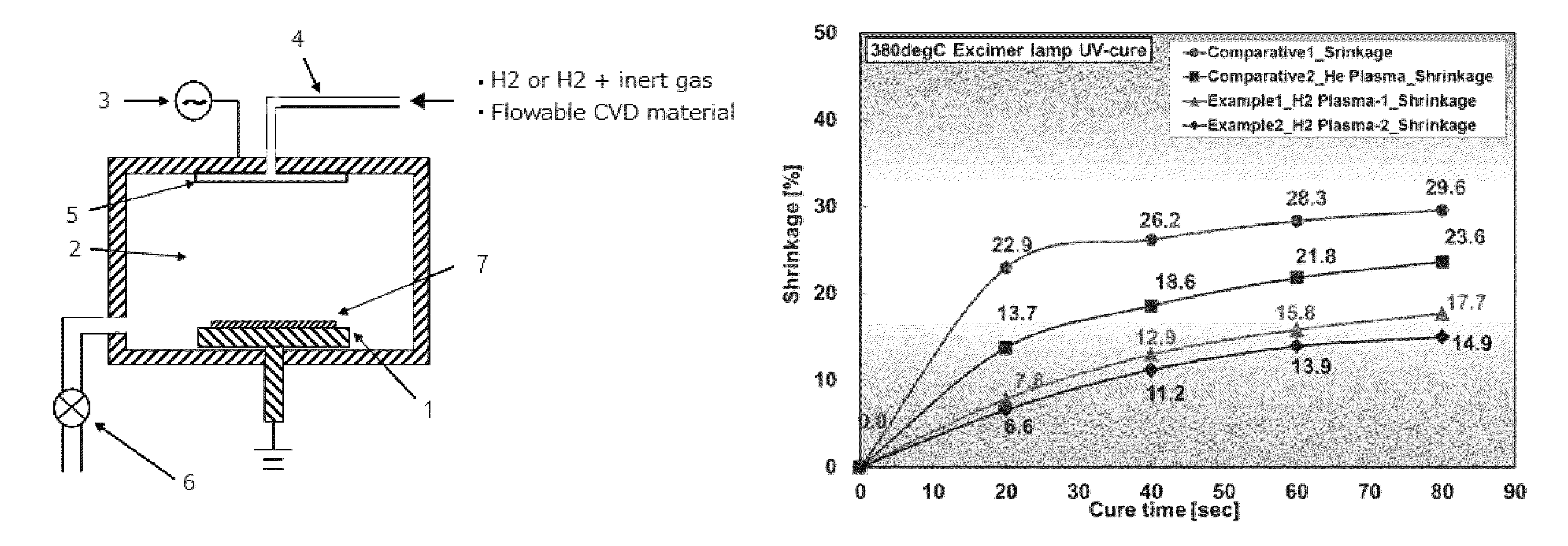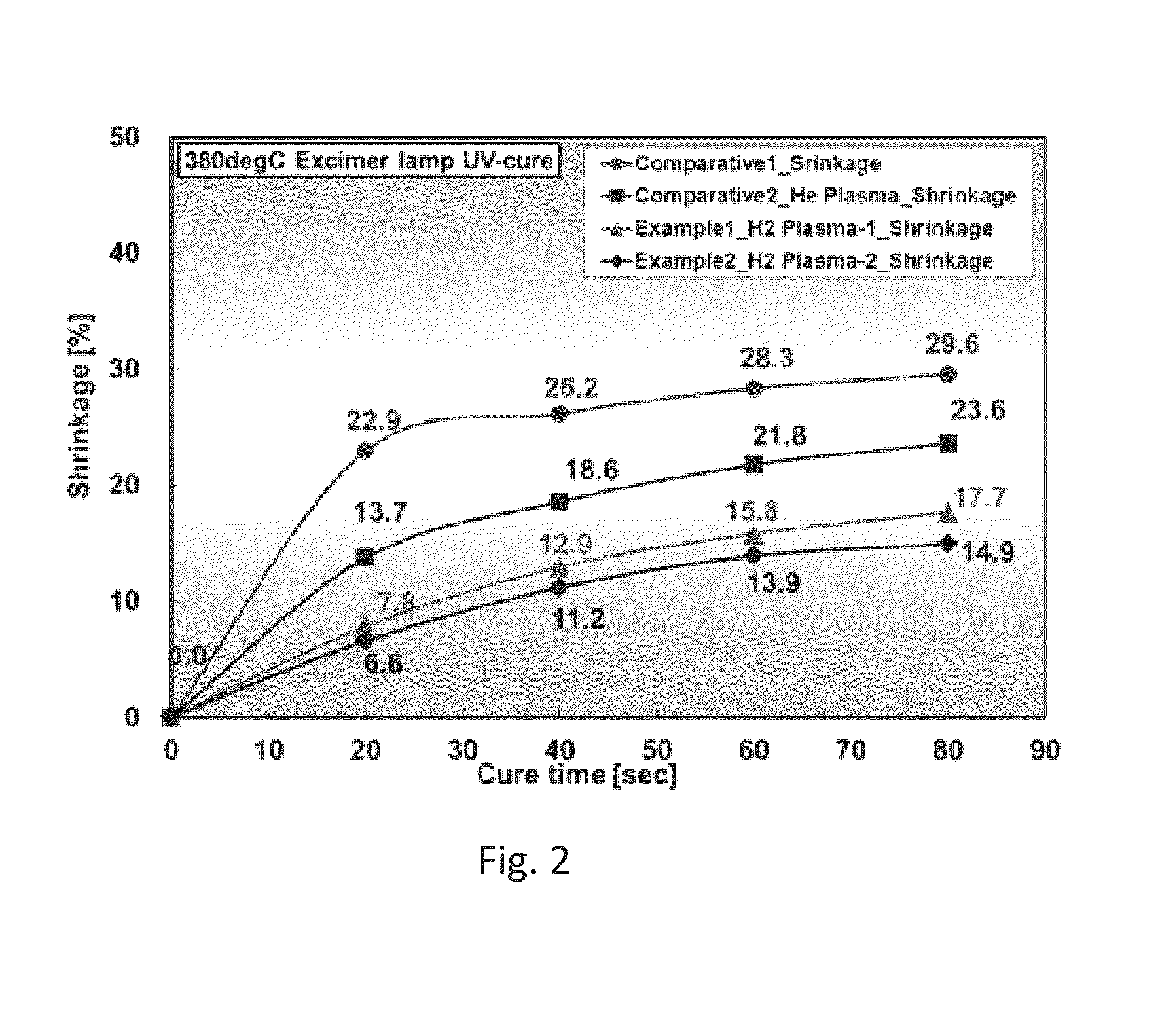Method for treating SiOCH film with hydrogen plasma
a technology of hydrogen plasma and sioch film, which is applied in the direction of basic electric elements, semiconductor/solid-state device manufacturing, electric apparatus, etc., can solve the problems of signal delay and increase in power consumption associated with multi-layer wiring structure, reduced advantage of using copper, and complicated process to prevent copper from diffusing in the sioch film
- Summary
- Abstract
- Description
- Claims
- Application Information
AI Technical Summary
Benefits of technology
Problems solved by technology
Method used
Image
Examples
example 1
H2 Plasma Treatment+High-Temperature UV-Curing
[0056]H2 plasma treatment was conducted on the film-deposited substrate in the same reaction chamber under conditions shown in Table 7 below.
[0057]
TABLE 7Substrate TemperatureRoom temperatureProcess Pressure500PaGas flow of H20.35 SLMRF power400 WDistance between electrodes8 mmDuration of H2 plasma treatment5 minutes
[0058]After the H2 plasma treatment, UV-curing was conducted in the same manner as in Comparative Example 2. Thereafter, film shrinkage was measured. The result is shown in FIG. 2 which is a graph showing the relationship between shrinkage [%] and cure time [sec]. As shown in FIG. 2, the film shrinkage by the UV-curing for 80 seconds was 17.7% which was about 25% lower than the film shrinkage when conducting He plasma treatment in Comparative Example 2. The mechanical strength of the film was also measured, and it was 9.2 GPa.
example 2
H2 Plasma Treatment+High-Temperature UV-Curing
[0059]H2 plasma treatment was conducted on the film-deposited substrate in the same reaction chamber under conditions shown in Table 8 below.
[0060]
TABLE 8Substrate TemperatureRoom temperatureProcess Pressure1100 PaGas flow of H20.5 SLMRF power400 WDistance between electrodes8 mmDuration of H2 plasma treatment5 minutes
[0061]After the H2 plasma treatment, UV-curing was conducted in the same manner as in Comparative Example 2. Thereafter, film shrinkage was measured. The result is shown in FIG. 2 which is a graph showing the relationship between shrinkage [%] and cure time [sec]. As shown in FIG. 2, the film shrinkage by the UV-curing for 80 seconds was 14.9% which was about 37% lower than the film shrinkage when conducting He plasma treatment in Comparative Example 2. The mechanical strength of the film was also measured, and it was 9.3 GPa.
[0062]Also, leakage current of the treated film was measured. The results are shown in FIG. 4. FIG. ...
example 3
Aminosilane Annealing+H2 Plasma Treatment+High-Temperature UV-Curing
[0063]Aminosilane annealing was conducted on the film-deposited substrate in the same reaction chamber under conditions shown in Table 9 below.
[0064]
TABLE 9Substrate TemperatureRoom temperatureAminosilaneDi-sec-buthylaminosilane (DSBAS)Process pressure15 PaDistance between electrodes 8 mmDuration of He plasma treatment60 seconds
[0065]After the aminosilane annealing, H2 plasma treatment was conducted on the film-deposited substrate in the same reaction chamber under conditions shown in Table 10 below.
[0066]
TABLE 10Substrate TemperatureRoom temperatureProcess Pressure1100 PaGas flow of H20.5 SLMRF power400 WDistance between electrodes8 mmDuration of H2 plasma treatment5 minutes
[0067]After the H2 plasma treatment, UV-curing was conducted in the same manner as in Comparative Example 3. Thereafter, film shrinkage was measured. The result is shown in FIG. 3 which is a graph showing the relationship between shrinkage [%] a...
PUM
 Login to View More
Login to View More Abstract
Description
Claims
Application Information
 Login to View More
Login to View More - R&D
- Intellectual Property
- Life Sciences
- Materials
- Tech Scout
- Unparalleled Data Quality
- Higher Quality Content
- 60% Fewer Hallucinations
Browse by: Latest US Patents, China's latest patents, Technical Efficacy Thesaurus, Application Domain, Technology Topic, Popular Technical Reports.
© 2025 PatSnap. All rights reserved.Legal|Privacy policy|Modern Slavery Act Transparency Statement|Sitemap|About US| Contact US: help@patsnap.com



